NSG2NCI Case Study: Cardiovascular Risks and Healthcare for Liz
VerifiedAdded on 2023/06/04
|9
|2395
|138
Case Study
AI Summary
This case study focuses on Patient Liz, a 49-year-old woman at high risk for developing cerebrovascular disorders due to factors like high blood pressure, physical inactivity, smoking, alcohol consumption, obesity, high cholesterol, ethnic background, and stress. The analysis identifies these risk factors and emphasizes the importance of primary healthcare services in addressing them. It discusses the role of general practitioners, primary health nurses, and community-based rehabilitation services like dieticians, social workers, and occupational therapists in providing comprehensive care. The study highlights the benefits of preventive and curative services offered by primary care centers, addressing physiological, social, and psychological determinants of health. Challenges such as financial constraints, poor health literacy, and the need for culturally competent care are also discussed. The case study underscores the necessity of a holistic approach to managing cardiovascular risks and improving patient outcomes. Desklib offers similar case studies and resources for students.
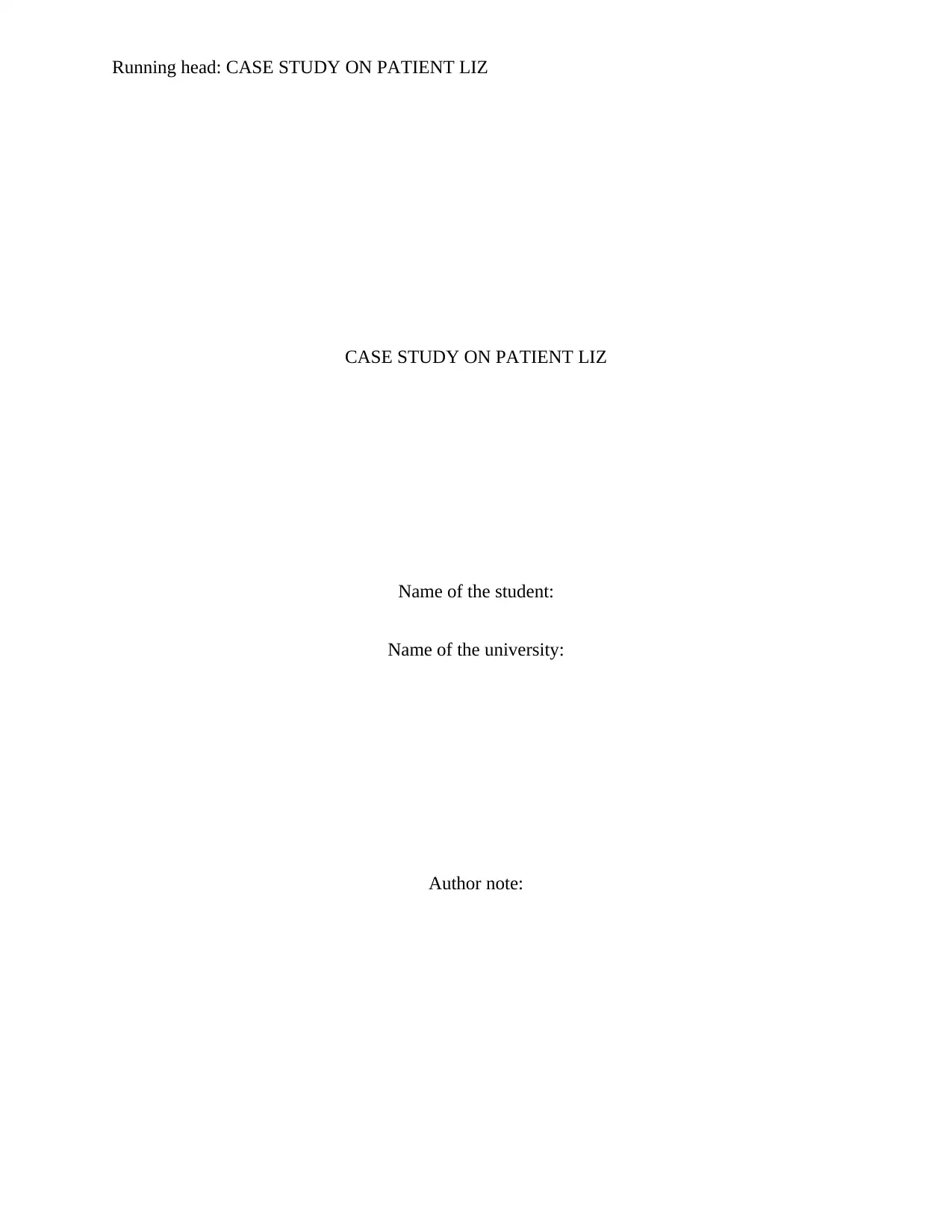
Running head: CASE STUDY ON PATIENT LIZ
CASE STUDY ON PATIENT LIZ
Name of the student:
Name of the university:
Author note:
CASE STUDY ON PATIENT LIZ
Name of the student:
Name of the university:
Author note:
Paraphrase This Document
Need a fresh take? Get an instant paraphrase of this document with our AI Paraphraser
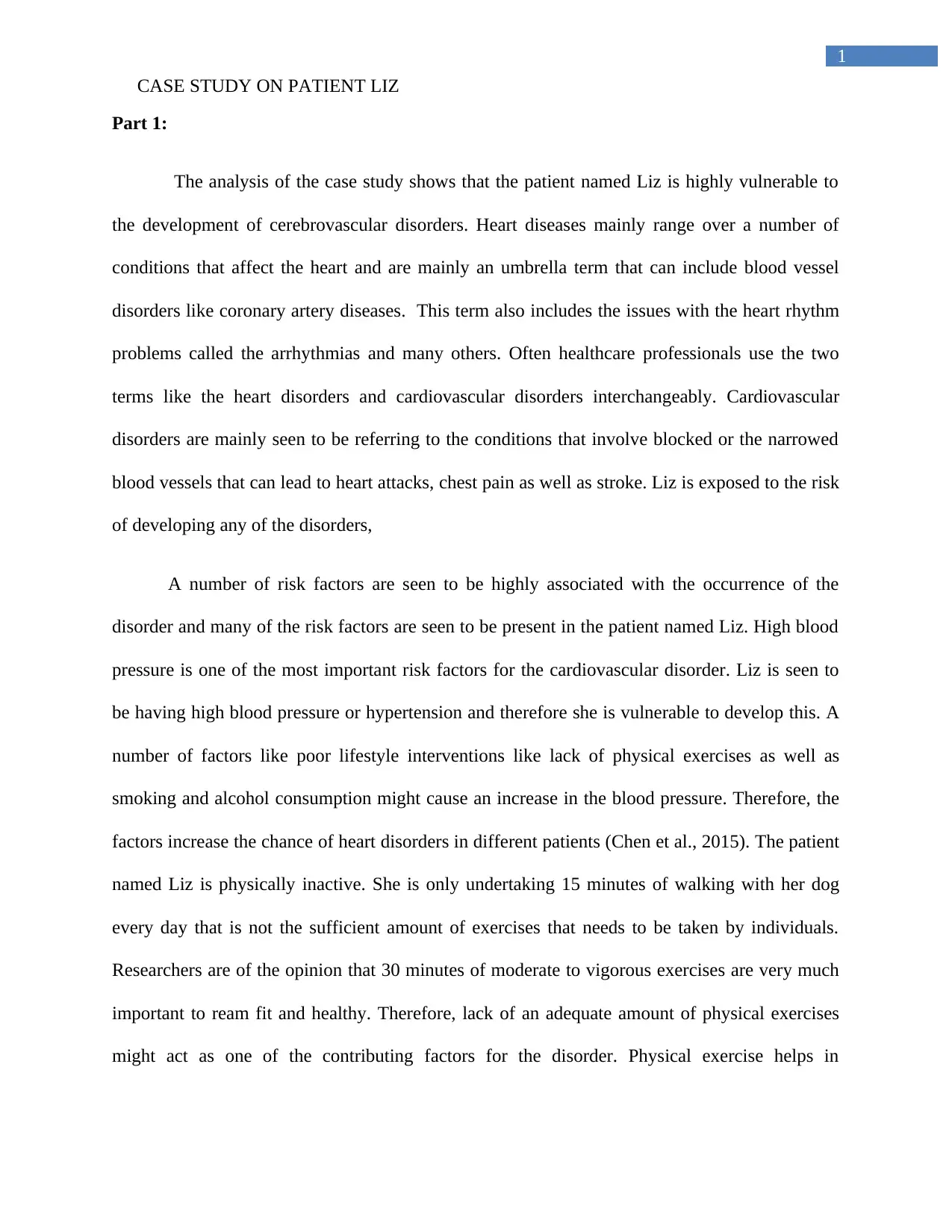
1
CASE STUDY ON PATIENT LIZ
Part 1:
The analysis of the case study shows that the patient named Liz is highly vulnerable to
the development of cerebrovascular disorders. Heart diseases mainly range over a number of
conditions that affect the heart and are mainly an umbrella term that can include blood vessel
disorders like coronary artery diseases. This term also includes the issues with the heart rhythm
problems called the arrhythmias and many others. Often healthcare professionals use the two
terms like the heart disorders and cardiovascular disorders interchangeably. Cardiovascular
disorders are mainly seen to be referring to the conditions that involve blocked or the narrowed
blood vessels that can lead to heart attacks, chest pain as well as stroke. Liz is exposed to the risk
of developing any of the disorders,
A number of risk factors are seen to be highly associated with the occurrence of the
disorder and many of the risk factors are seen to be present in the patient named Liz. High blood
pressure is one of the most important risk factors for the cardiovascular disorder. Liz is seen to
be having high blood pressure or hypertension and therefore she is vulnerable to develop this. A
number of factors like poor lifestyle interventions like lack of physical exercises as well as
smoking and alcohol consumption might cause an increase in the blood pressure. Therefore, the
factors increase the chance of heart disorders in different patients (Chen et al., 2015). The patient
named Liz is physically inactive. She is only undertaking 15 minutes of walking with her dog
every day that is not the sufficient amount of exercises that needs to be taken by individuals.
Researchers are of the opinion that 30 minutes of moderate to vigorous exercises are very much
important to ream fit and healthy. Therefore, lack of an adequate amount of physical exercises
might act as one of the contributing factors for the disorder. Physical exercise helps in
CASE STUDY ON PATIENT LIZ
Part 1:
The analysis of the case study shows that the patient named Liz is highly vulnerable to
the development of cerebrovascular disorders. Heart diseases mainly range over a number of
conditions that affect the heart and are mainly an umbrella term that can include blood vessel
disorders like coronary artery diseases. This term also includes the issues with the heart rhythm
problems called the arrhythmias and many others. Often healthcare professionals use the two
terms like the heart disorders and cardiovascular disorders interchangeably. Cardiovascular
disorders are mainly seen to be referring to the conditions that involve blocked or the narrowed
blood vessels that can lead to heart attacks, chest pain as well as stroke. Liz is exposed to the risk
of developing any of the disorders,
A number of risk factors are seen to be highly associated with the occurrence of the
disorder and many of the risk factors are seen to be present in the patient named Liz. High blood
pressure is one of the most important risk factors for the cardiovascular disorder. Liz is seen to
be having high blood pressure or hypertension and therefore she is vulnerable to develop this. A
number of factors like poor lifestyle interventions like lack of physical exercises as well as
smoking and alcohol consumption might cause an increase in the blood pressure. Therefore, the
factors increase the chance of heart disorders in different patients (Chen et al., 2015). The patient
named Liz is physically inactive. She is only undertaking 15 minutes of walking with her dog
every day that is not the sufficient amount of exercises that needs to be taken by individuals.
Researchers are of the opinion that 30 minutes of moderate to vigorous exercises are very much
important to ream fit and healthy. Therefore, lack of an adequate amount of physical exercises
might act as one of the contributing factors for the disorder. Physical exercise helps in
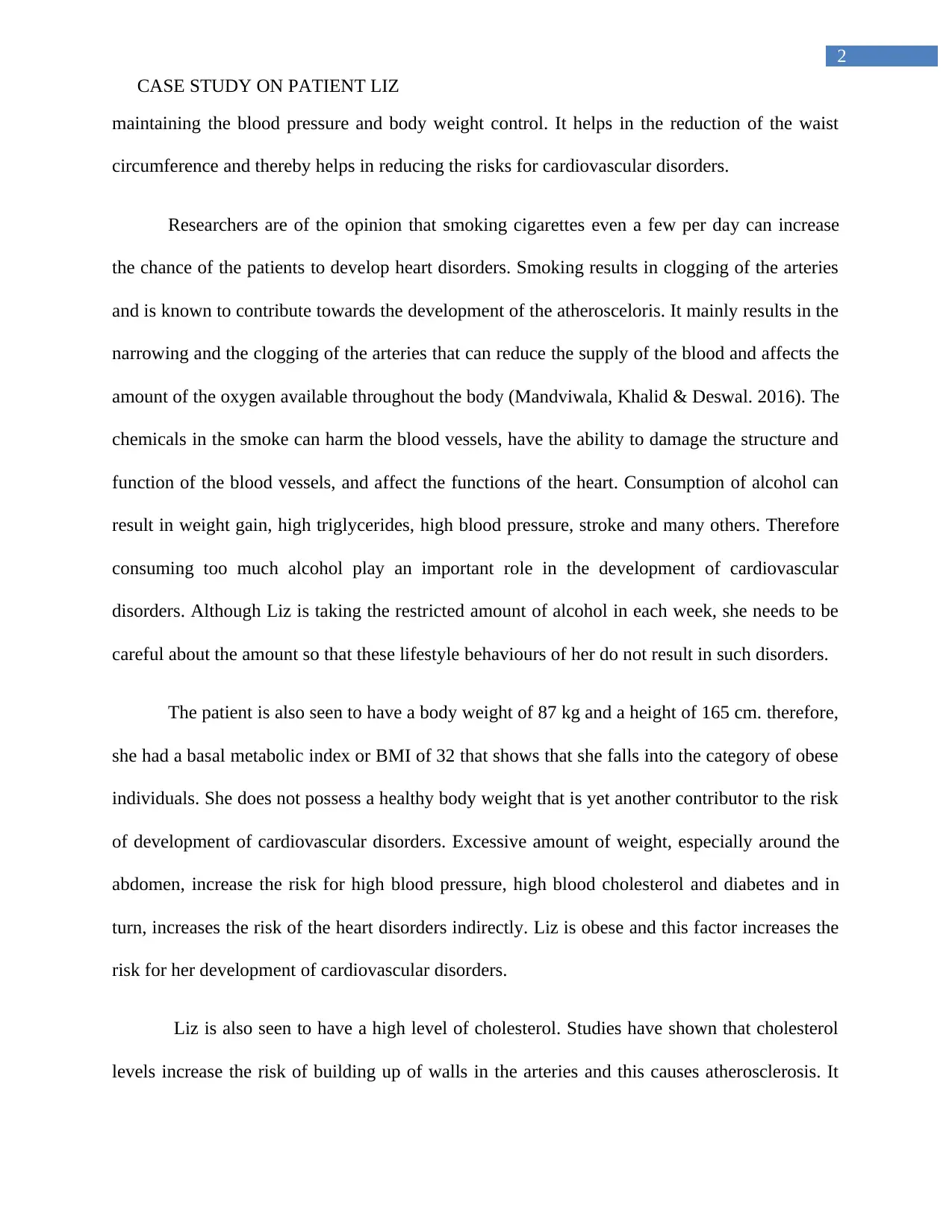
2
CASE STUDY ON PATIENT LIZ
maintaining the blood pressure and body weight control. It helps in the reduction of the waist
circumference and thereby helps in reducing the risks for cardiovascular disorders.
Researchers are of the opinion that smoking cigarettes even a few per day can increase
the chance of the patients to develop heart disorders. Smoking results in clogging of the arteries
and is known to contribute towards the development of the atherosceloris. It mainly results in the
narrowing and the clogging of the arteries that can reduce the supply of the blood and affects the
amount of the oxygen available throughout the body (Mandviwala, Khalid & Deswal. 2016). The
chemicals in the smoke can harm the blood vessels, have the ability to damage the structure and
function of the blood vessels, and affect the functions of the heart. Consumption of alcohol can
result in weight gain, high triglycerides, high blood pressure, stroke and many others. Therefore
consuming too much alcohol play an important role in the development of cardiovascular
disorders. Although Liz is taking the restricted amount of alcohol in each week, she needs to be
careful about the amount so that these lifestyle behaviours of her do not result in such disorders.
The patient is also seen to have a body weight of 87 kg and a height of 165 cm. therefore,
she had a basal metabolic index or BMI of 32 that shows that she falls into the category of obese
individuals. She does not possess a healthy body weight that is yet another contributor to the risk
of development of cardiovascular disorders. Excessive amount of weight, especially around the
abdomen, increase the risk for high blood pressure, high blood cholesterol and diabetes and in
turn, increases the risk of the heart disorders indirectly. Liz is obese and this factor increases the
risk for her development of cardiovascular disorders.
Liz is also seen to have a high level of cholesterol. Studies have shown that cholesterol
levels increase the risk of building up of walls in the arteries and this causes atherosclerosis. It
CASE STUDY ON PATIENT LIZ
maintaining the blood pressure and body weight control. It helps in the reduction of the waist
circumference and thereby helps in reducing the risks for cardiovascular disorders.
Researchers are of the opinion that smoking cigarettes even a few per day can increase
the chance of the patients to develop heart disorders. Smoking results in clogging of the arteries
and is known to contribute towards the development of the atherosceloris. It mainly results in the
narrowing and the clogging of the arteries that can reduce the supply of the blood and affects the
amount of the oxygen available throughout the body (Mandviwala, Khalid & Deswal. 2016). The
chemicals in the smoke can harm the blood vessels, have the ability to damage the structure and
function of the blood vessels, and affect the functions of the heart. Consumption of alcohol can
result in weight gain, high triglycerides, high blood pressure, stroke and many others. Therefore
consuming too much alcohol play an important role in the development of cardiovascular
disorders. Although Liz is taking the restricted amount of alcohol in each week, she needs to be
careful about the amount so that these lifestyle behaviours of her do not result in such disorders.
The patient is also seen to have a body weight of 87 kg and a height of 165 cm. therefore,
she had a basal metabolic index or BMI of 32 that shows that she falls into the category of obese
individuals. She does not possess a healthy body weight that is yet another contributor to the risk
of development of cardiovascular disorders. Excessive amount of weight, especially around the
abdomen, increase the risk for high blood pressure, high blood cholesterol and diabetes and in
turn, increases the risk of the heart disorders indirectly. Liz is obese and this factor increases the
risk for her development of cardiovascular disorders.
Liz is also seen to have a high level of cholesterol. Studies have shown that cholesterol
levels increase the risk of building up of walls in the arteries and this causes atherosclerosis. It
⊘ This is a preview!⊘
Do you want full access?
Subscribe today to unlock all pages.

Trusted by 1+ million students worldwide
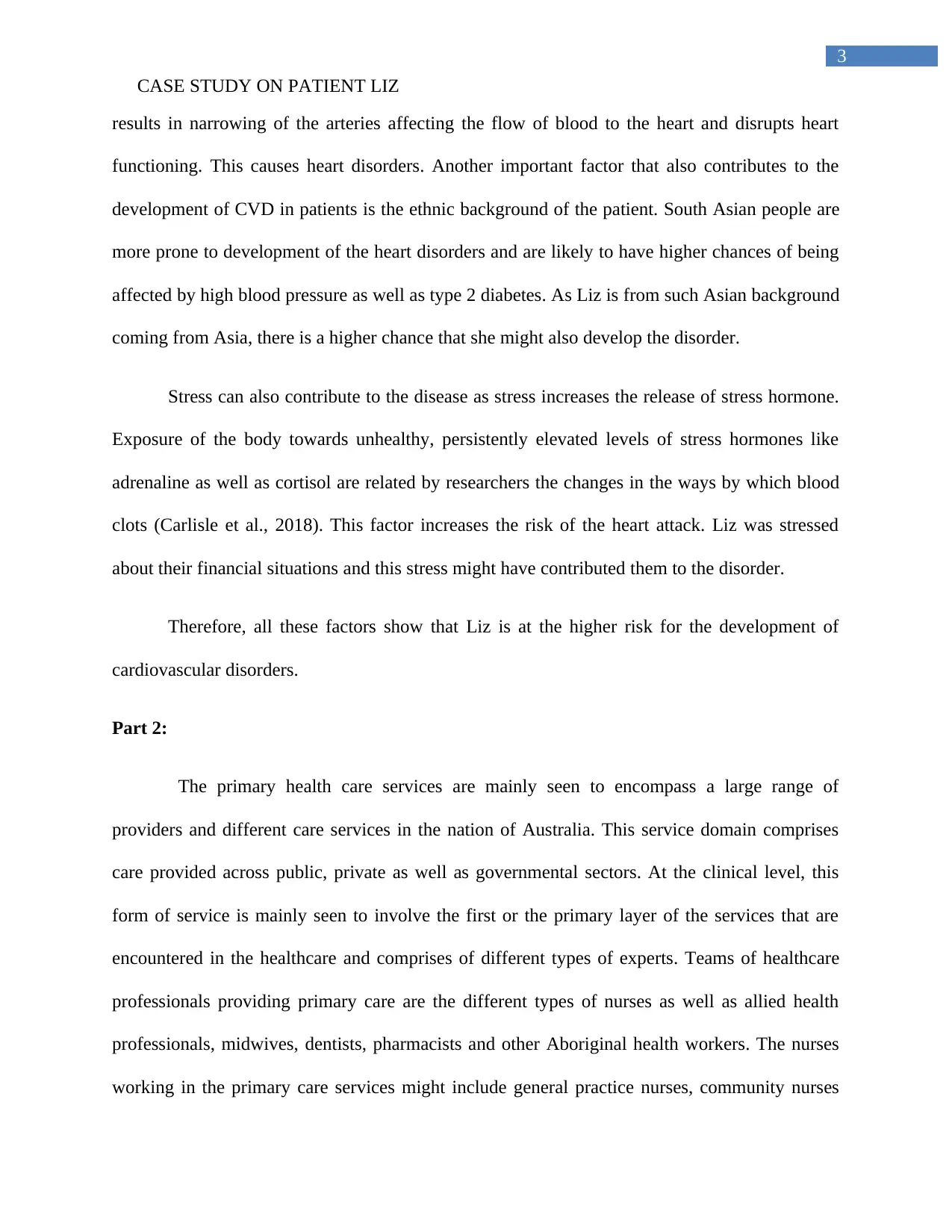
3
CASE STUDY ON PATIENT LIZ
results in narrowing of the arteries affecting the flow of blood to the heart and disrupts heart
functioning. This causes heart disorders. Another important factor that also contributes to the
development of CVD in patients is the ethnic background of the patient. South Asian people are
more prone to development of the heart disorders and are likely to have higher chances of being
affected by high blood pressure as well as type 2 diabetes. As Liz is from such Asian background
coming from Asia, there is a higher chance that she might also develop the disorder.
Stress can also contribute to the disease as stress increases the release of stress hormone.
Exposure of the body towards unhealthy, persistently elevated levels of stress hormones like
adrenaline as well as cortisol are related by researchers the changes in the ways by which blood
clots (Carlisle et al., 2018). This factor increases the risk of the heart attack. Liz was stressed
about their financial situations and this stress might have contributed them to the disorder.
Therefore, all these factors show that Liz is at the higher risk for the development of
cardiovascular disorders.
Part 2:
The primary health care services are mainly seen to encompass a large range of
providers and different care services in the nation of Australia. This service domain comprises
care provided across public, private as well as governmental sectors. At the clinical level, this
form of service is mainly seen to involve the first or the primary layer of the services that are
encountered in the healthcare and comprises of different types of experts. Teams of healthcare
professionals providing primary care are the different types of nurses as well as allied health
professionals, midwives, dentists, pharmacists and other Aboriginal health workers. The nurses
working in the primary care services might include general practice nurses, community nurses
CASE STUDY ON PATIENT LIZ
results in narrowing of the arteries affecting the flow of blood to the heart and disrupts heart
functioning. This causes heart disorders. Another important factor that also contributes to the
development of CVD in patients is the ethnic background of the patient. South Asian people are
more prone to development of the heart disorders and are likely to have higher chances of being
affected by high blood pressure as well as type 2 diabetes. As Liz is from such Asian background
coming from Asia, there is a higher chance that she might also develop the disorder.
Stress can also contribute to the disease as stress increases the release of stress hormone.
Exposure of the body towards unhealthy, persistently elevated levels of stress hormones like
adrenaline as well as cortisol are related by researchers the changes in the ways by which blood
clots (Carlisle et al., 2018). This factor increases the risk of the heart attack. Liz was stressed
about their financial situations and this stress might have contributed them to the disorder.
Therefore, all these factors show that Liz is at the higher risk for the development of
cardiovascular disorders.
Part 2:
The primary health care services are mainly seen to encompass a large range of
providers and different care services in the nation of Australia. This service domain comprises
care provided across public, private as well as governmental sectors. At the clinical level, this
form of service is mainly seen to involve the first or the primary layer of the services that are
encountered in the healthcare and comprises of different types of experts. Teams of healthcare
professionals providing primary care are the different types of nurses as well as allied health
professionals, midwives, dentists, pharmacists and other Aboriginal health workers. The nurses
working in the primary care services might include general practice nurses, community nurses
Paraphrase This Document
Need a fresh take? Get an instant paraphrase of this document with our AI Paraphraser
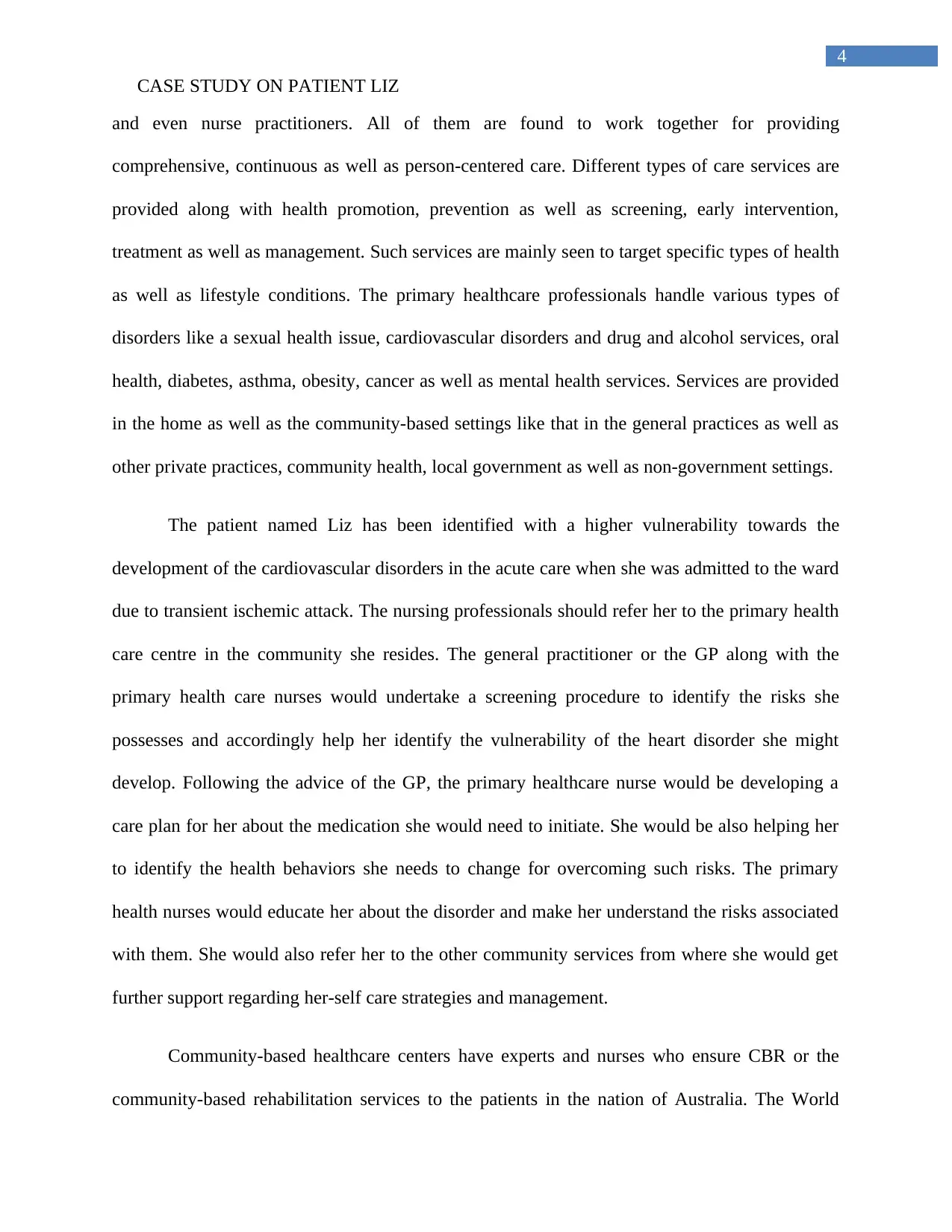
4
CASE STUDY ON PATIENT LIZ
and even nurse practitioners. All of them are found to work together for providing
comprehensive, continuous as well as person-centered care. Different types of care services are
provided along with health promotion, prevention as well as screening, early intervention,
treatment as well as management. Such services are mainly seen to target specific types of health
as well as lifestyle conditions. The primary healthcare professionals handle various types of
disorders like a sexual health issue, cardiovascular disorders and drug and alcohol services, oral
health, diabetes, asthma, obesity, cancer as well as mental health services. Services are provided
in the home as well as the community-based settings like that in the general practices as well as
other private practices, community health, local government as well as non-government settings.
The patient named Liz has been identified with a higher vulnerability towards the
development of the cardiovascular disorders in the acute care when she was admitted to the ward
due to transient ischemic attack. The nursing professionals should refer her to the primary health
care centre in the community she resides. The general practitioner or the GP along with the
primary health care nurses would undertake a screening procedure to identify the risks she
possesses and accordingly help her identify the vulnerability of the heart disorder she might
develop. Following the advice of the GP, the primary healthcare nurse would be developing a
care plan for her about the medication she would need to initiate. She would be also helping her
to identify the health behaviors she needs to change for overcoming such risks. The primary
health nurses would educate her about the disorder and make her understand the risks associated
with them. She would also refer her to the other community services from where she would get
further support regarding her-self care strategies and management.
Community-based healthcare centers have experts and nurses who ensure CBR or the
community-based rehabilitation services to the patients in the nation of Australia. The World
CASE STUDY ON PATIENT LIZ
and even nurse practitioners. All of them are found to work together for providing
comprehensive, continuous as well as person-centered care. Different types of care services are
provided along with health promotion, prevention as well as screening, early intervention,
treatment as well as management. Such services are mainly seen to target specific types of health
as well as lifestyle conditions. The primary healthcare professionals handle various types of
disorders like a sexual health issue, cardiovascular disorders and drug and alcohol services, oral
health, diabetes, asthma, obesity, cancer as well as mental health services. Services are provided
in the home as well as the community-based settings like that in the general practices as well as
other private practices, community health, local government as well as non-government settings.
The patient named Liz has been identified with a higher vulnerability towards the
development of the cardiovascular disorders in the acute care when she was admitted to the ward
due to transient ischemic attack. The nursing professionals should refer her to the primary health
care centre in the community she resides. The general practitioner or the GP along with the
primary health care nurses would undertake a screening procedure to identify the risks she
possesses and accordingly help her identify the vulnerability of the heart disorder she might
develop. Following the advice of the GP, the primary healthcare nurse would be developing a
care plan for her about the medication she would need to initiate. She would be also helping her
to identify the health behaviors she needs to change for overcoming such risks. The primary
health nurses would educate her about the disorder and make her understand the risks associated
with them. She would also refer her to the other community services from where she would get
further support regarding her-self care strategies and management.
Community-based healthcare centers have experts and nurses who ensure CBR or the
community-based rehabilitation services to the patients in the nation of Australia. The World
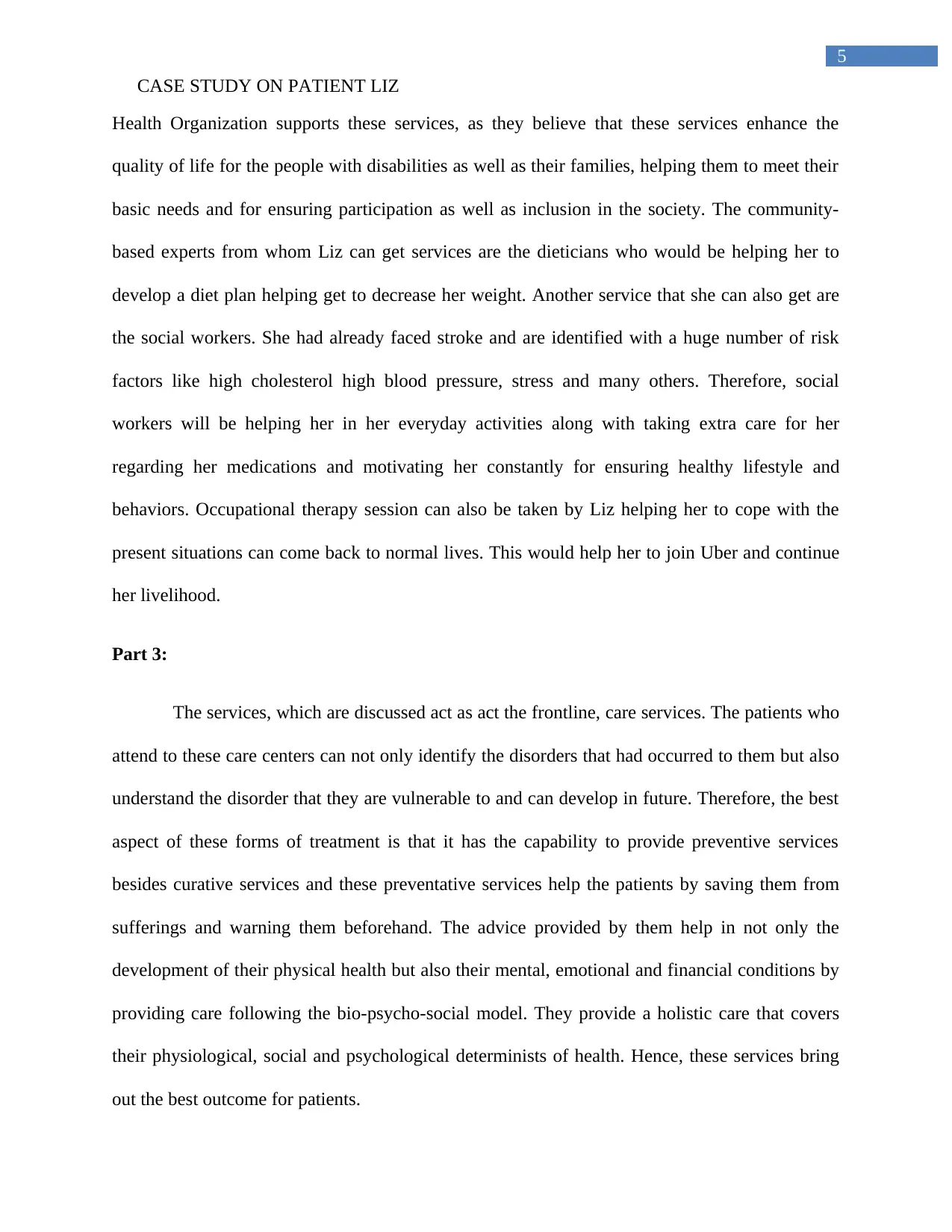
5
CASE STUDY ON PATIENT LIZ
Health Organization supports these services, as they believe that these services enhance the
quality of life for the people with disabilities as well as their families, helping them to meet their
basic needs and for ensuring participation as well as inclusion in the society. The community-
based experts from whom Liz can get services are the dieticians who would be helping her to
develop a diet plan helping get to decrease her weight. Another service that she can also get are
the social workers. She had already faced stroke and are identified with a huge number of risk
factors like high cholesterol high blood pressure, stress and many others. Therefore, social
workers will be helping her in her everyday activities along with taking extra care for her
regarding her medications and motivating her constantly for ensuring healthy lifestyle and
behaviors. Occupational therapy session can also be taken by Liz helping her to cope with the
present situations can come back to normal lives. This would help her to join Uber and continue
her livelihood.
Part 3:
The services, which are discussed act as act the frontline, care services. The patients who
attend to these care centers can not only identify the disorders that had occurred to them but also
understand the disorder that they are vulnerable to and can develop in future. Therefore, the best
aspect of these forms of treatment is that it has the capability to provide preventive services
besides curative services and these preventative services help the patients by saving them from
sufferings and warning them beforehand. The advice provided by them help in not only the
development of their physical health but also their mental, emotional and financial conditions by
providing care following the bio-psycho-social model. They provide a holistic care that covers
their physiological, social and psychological determinists of health. Hence, these services bring
out the best outcome for patients.
CASE STUDY ON PATIENT LIZ
Health Organization supports these services, as they believe that these services enhance the
quality of life for the people with disabilities as well as their families, helping them to meet their
basic needs and for ensuring participation as well as inclusion in the society. The community-
based experts from whom Liz can get services are the dieticians who would be helping her to
develop a diet plan helping get to decrease her weight. Another service that she can also get are
the social workers. She had already faced stroke and are identified with a huge number of risk
factors like high cholesterol high blood pressure, stress and many others. Therefore, social
workers will be helping her in her everyday activities along with taking extra care for her
regarding her medications and motivating her constantly for ensuring healthy lifestyle and
behaviors. Occupational therapy session can also be taken by Liz helping her to cope with the
present situations can come back to normal lives. This would help her to join Uber and continue
her livelihood.
Part 3:
The services, which are discussed act as act the frontline, care services. The patients who
attend to these care centers can not only identify the disorders that had occurred to them but also
understand the disorder that they are vulnerable to and can develop in future. Therefore, the best
aspect of these forms of treatment is that it has the capability to provide preventive services
besides curative services and these preventative services help the patients by saving them from
sufferings and warning them beforehand. The advice provided by them help in not only the
development of their physical health but also their mental, emotional and financial conditions by
providing care following the bio-psycho-social model. They provide a holistic care that covers
their physiological, social and psychological determinists of health. Hence, these services bring
out the best outcome for patients.
⊘ This is a preview!⊘
Do you want full access?
Subscribe today to unlock all pages.

Trusted by 1+ million students worldwide
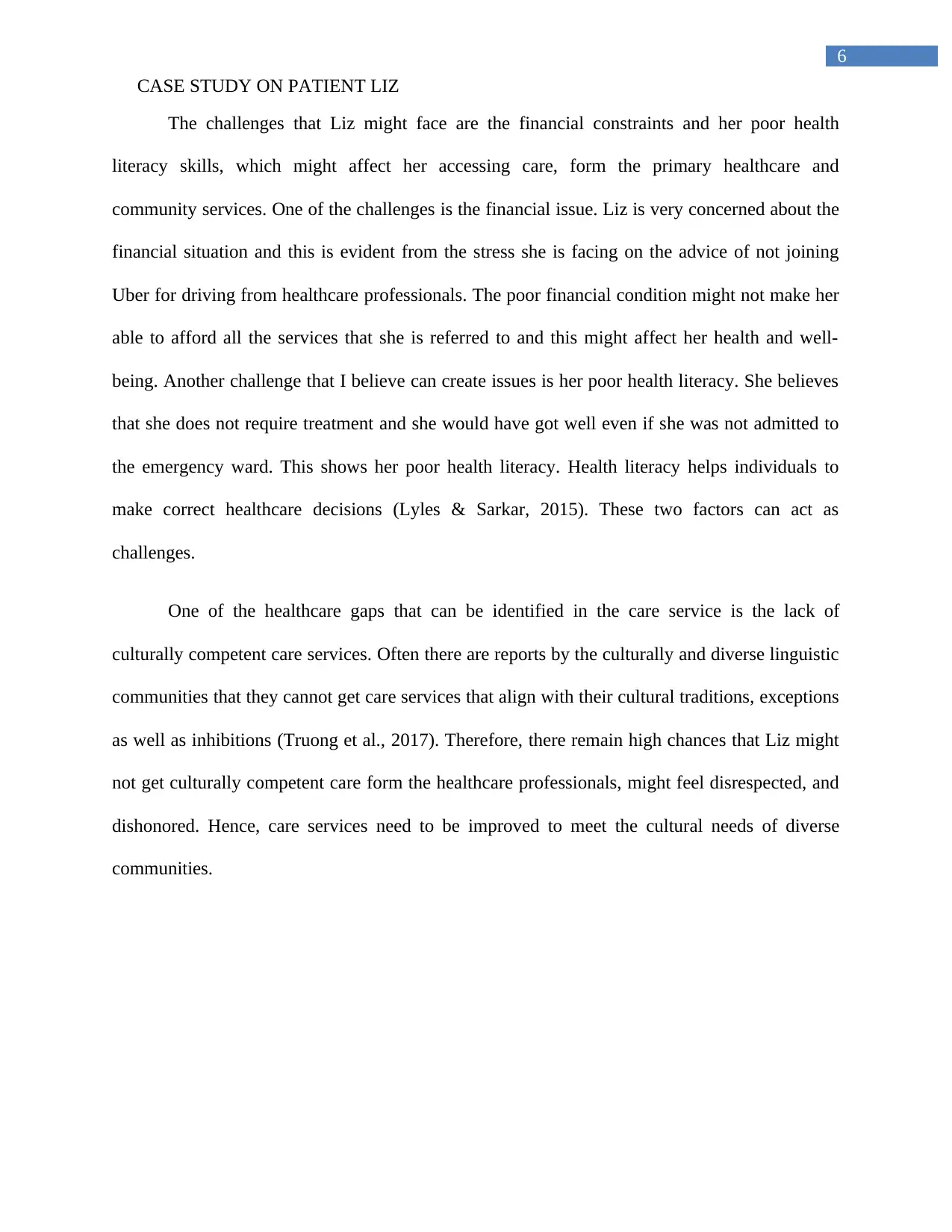
6
CASE STUDY ON PATIENT LIZ
The challenges that Liz might face are the financial constraints and her poor health
literacy skills, which might affect her accessing care, form the primary healthcare and
community services. One of the challenges is the financial issue. Liz is very concerned about the
financial situation and this is evident from the stress she is facing on the advice of not joining
Uber for driving from healthcare professionals. The poor financial condition might not make her
able to afford all the services that she is referred to and this might affect her health and well-
being. Another challenge that I believe can create issues is her poor health literacy. She believes
that she does not require treatment and she would have got well even if she was not admitted to
the emergency ward. This shows her poor health literacy. Health literacy helps individuals to
make correct healthcare decisions (Lyles & Sarkar, 2015). These two factors can act as
challenges.
One of the healthcare gaps that can be identified in the care service is the lack of
culturally competent care services. Often there are reports by the culturally and diverse linguistic
communities that they cannot get care services that align with their cultural traditions, exceptions
as well as inhibitions (Truong et al., 2017). Therefore, there remain high chances that Liz might
not get culturally competent care form the healthcare professionals, might feel disrespected, and
dishonored. Hence, care services need to be improved to meet the cultural needs of diverse
communities.
CASE STUDY ON PATIENT LIZ
The challenges that Liz might face are the financial constraints and her poor health
literacy skills, which might affect her accessing care, form the primary healthcare and
community services. One of the challenges is the financial issue. Liz is very concerned about the
financial situation and this is evident from the stress she is facing on the advice of not joining
Uber for driving from healthcare professionals. The poor financial condition might not make her
able to afford all the services that she is referred to and this might affect her health and well-
being. Another challenge that I believe can create issues is her poor health literacy. She believes
that she does not require treatment and she would have got well even if she was not admitted to
the emergency ward. This shows her poor health literacy. Health literacy helps individuals to
make correct healthcare decisions (Lyles & Sarkar, 2015). These two factors can act as
challenges.
One of the healthcare gaps that can be identified in the care service is the lack of
culturally competent care services. Often there are reports by the culturally and diverse linguistic
communities that they cannot get care services that align with their cultural traditions, exceptions
as well as inhibitions (Truong et al., 2017). Therefore, there remain high chances that Liz might
not get culturally competent care form the healthcare professionals, might feel disrespected, and
dishonored. Hence, care services need to be improved to meet the cultural needs of diverse
communities.
Paraphrase This Document
Need a fresh take? Get an instant paraphrase of this document with our AI Paraphraser
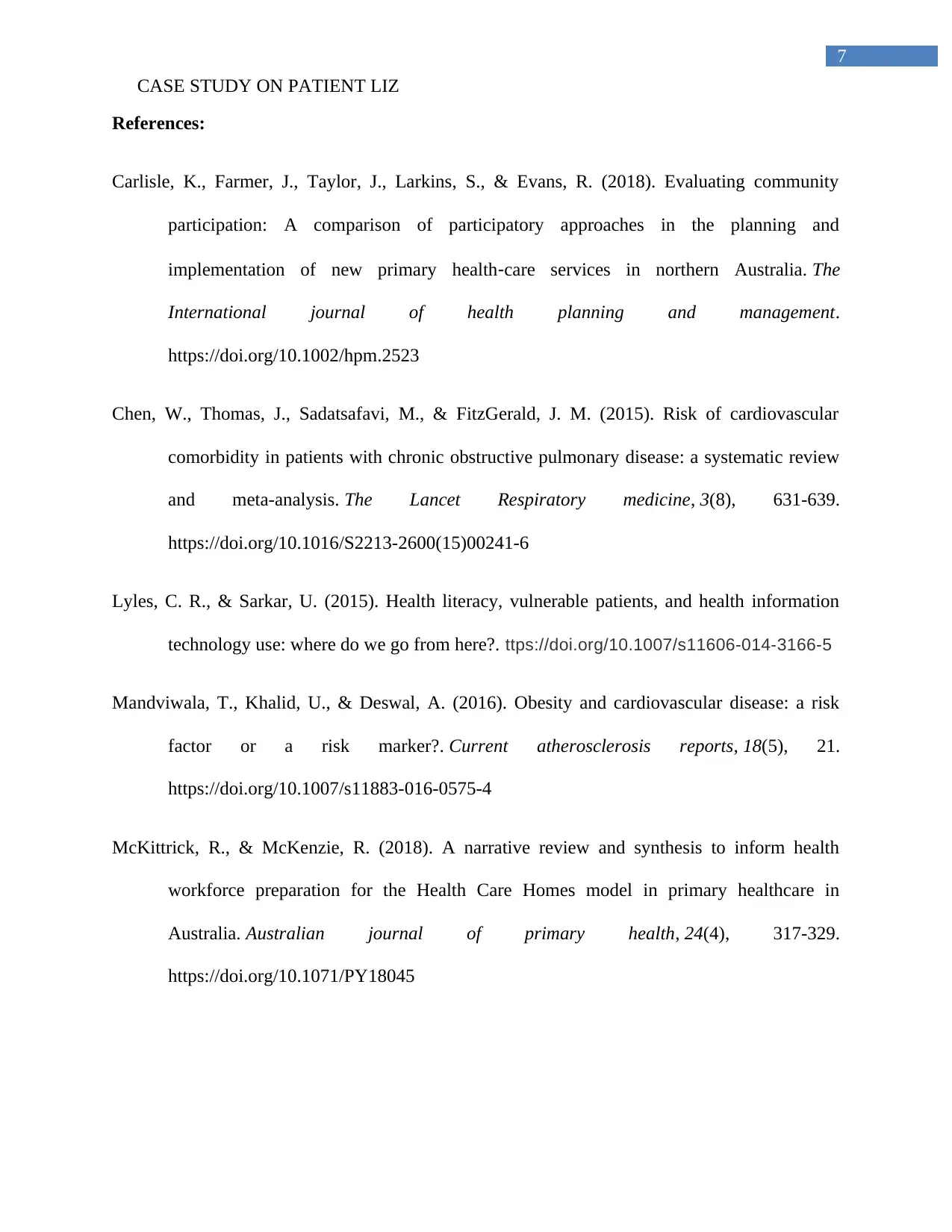
7
CASE STUDY ON PATIENT LIZ
References:
Carlisle, K., Farmer, J., Taylor, J., Larkins, S., & Evans, R. (2018). Evaluating community
participation: A comparison of participatory approaches in the planning and
implementation of new primary health‐care services in northern Australia. The
International journal of health planning and management.
https://doi.org/10.1002/hpm.2523
Chen, W., Thomas, J., Sadatsafavi, M., & FitzGerald, J. M. (2015). Risk of cardiovascular
comorbidity in patients with chronic obstructive pulmonary disease: a systematic review
and meta-analysis. The Lancet Respiratory medicine, 3(8), 631-639.
https://doi.org/10.1016/S2213-2600(15)00241-6
Lyles, C. R., & Sarkar, U. (2015). Health literacy, vulnerable patients, and health information
technology use: where do we go from here?. ttps://doi.org/10.1007/s11606-014-3166-5
Mandviwala, T., Khalid, U., & Deswal, A. (2016). Obesity and cardiovascular disease: a risk
factor or a risk marker?. Current atherosclerosis reports, 18(5), 21.
https://doi.org/10.1007/s11883-016-0575-4
McKittrick, R., & McKenzie, R. (2018). A narrative review and synthesis to inform health
workforce preparation for the Health Care Homes model in primary healthcare in
Australia. Australian journal of primary health, 24(4), 317-329.
https://doi.org/10.1071/PY18045
CASE STUDY ON PATIENT LIZ
References:
Carlisle, K., Farmer, J., Taylor, J., Larkins, S., & Evans, R. (2018). Evaluating community
participation: A comparison of participatory approaches in the planning and
implementation of new primary health‐care services in northern Australia. The
International journal of health planning and management.
https://doi.org/10.1002/hpm.2523
Chen, W., Thomas, J., Sadatsafavi, M., & FitzGerald, J. M. (2015). Risk of cardiovascular
comorbidity in patients with chronic obstructive pulmonary disease: a systematic review
and meta-analysis. The Lancet Respiratory medicine, 3(8), 631-639.
https://doi.org/10.1016/S2213-2600(15)00241-6
Lyles, C. R., & Sarkar, U. (2015). Health literacy, vulnerable patients, and health information
technology use: where do we go from here?. ttps://doi.org/10.1007/s11606-014-3166-5
Mandviwala, T., Khalid, U., & Deswal, A. (2016). Obesity and cardiovascular disease: a risk
factor or a risk marker?. Current atherosclerosis reports, 18(5), 21.
https://doi.org/10.1007/s11883-016-0575-4
McKittrick, R., & McKenzie, R. (2018). A narrative review and synthesis to inform health
workforce preparation for the Health Care Homes model in primary healthcare in
Australia. Australian journal of primary health, 24(4), 317-329.
https://doi.org/10.1071/PY18045

8
CASE STUDY ON PATIENT LIZ
Truong, M., Gibbs, L., Paradies, Y., Priest, N., & Tadic, M. (2017). Cultural competence in the
community health context:‘we don’t have to reinvent the wheel’. Australian journal of
primary health, 23(4), 342-347. https://doi.org/10.1071/PY16073
CASE STUDY ON PATIENT LIZ
Truong, M., Gibbs, L., Paradies, Y., Priest, N., & Tadic, M. (2017). Cultural competence in the
community health context:‘we don’t have to reinvent the wheel’. Australian journal of
primary health, 23(4), 342-347. https://doi.org/10.1071/PY16073
⊘ This is a preview!⊘
Do you want full access?
Subscribe today to unlock all pages.

Trusted by 1+ million students worldwide
1 out of 9
Related Documents
Your All-in-One AI-Powered Toolkit for Academic Success.
+13062052269
info@desklib.com
Available 24*7 on WhatsApp / Email
![[object Object]](/_next/static/media/star-bottom.7253800d.svg)
Unlock your academic potential
Copyright © 2020–2025 A2Z Services. All Rights Reserved. Developed and managed by ZUCOL.





